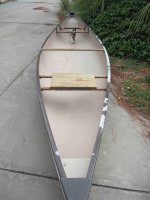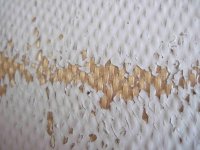Removing the gunnels and then working on them is an excellent suggestion. None of the rivets are loose, but it is not difficult at all to drill them out.
One advantage to that approach is one doesn't have to drill any new holes - simply re-install using the existing holes. I wonder if the aluminum has been formed into shape and the curve that is needed in them is set in place. Or upon removal will the aluminum "spring" back to its original linear property and require 4 or 6 hands to force the aluminum back to the curves that are needed?
Willie, I like that idea best of all. Once those aluminum gunwales have their factory installed sheerline warp to them I believe they will largely retain their shape. Aluminum gunwales that have been pinned certainly want to retain that shape.
I guess you should be able to hit the old holes with new pop rivets. Of course is something does slip 1/8 inch out of alignment you’ll have to redrill a new hole awfully adjacent to an old existing hole, and if those two holes overlap you’ll have a sloppy through hull connection. Still, if it worked, everything including the yoke and carry hands could go back in their original gunwale holes. I like the no new holes idea.
I do not know how manufacturers install their aluminum gunwales, but I suspect that they may have machinery to pre-bend them to specific model hull shapes, both along the curves ( ) and along the rise from center depth to stem. That would make factory floor installation much easier.
Does anyone know? Do manufacturers pre-bend their aluminum gunwales to some custom curvature, making OEM installation easier?
I like the idea of having the gunwales off completely to assist in removing the cladding on the gunwale sides where you might inadvertently scrape up the hull. But I’d try running an RO sander with 220 grit or so along the still pop riveted firmly in place flat gunwale top before removing them. You won’t build a better jig to hold them in place than that.
If it proves too difficult a task to mechanically remove the flat topside layer of cladding with an RO sander I’d think hand sanding the edges would be a true PITA.
If you take the gunwales off you could experiment with some stripper to help remove the whatever the hell that is. A can of paint, varnish or ? stripper applied with the gunwales removed might save a lot of time and elbow grease.
Given the anodizing information supplied in responses above, those ain’t anodized. Allow me:
http://bfy.tw/1D7c

